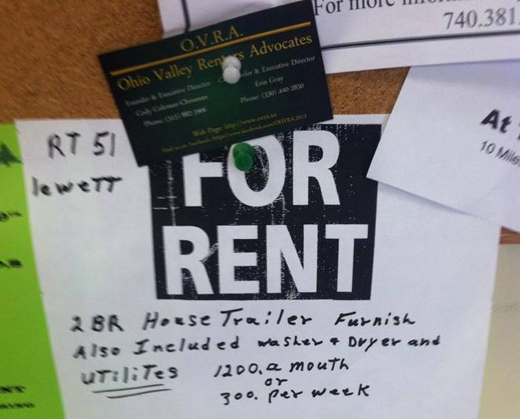
CARROLLTON, Ohio – Concerned citizens crowded into a local church here July 10 for a town hall style meeting. They were there to hear Cody Coleman-Chrisman, founder and executive director of Ohio Valley Renters Advocates (OVRA), with a panel of experts who came to advise on fracking’s latest but not least harmful effect on our eastern Ohio communities: housing shortages and the rent-gouging that followed.
This meeting had been organized by OVRA and Caitlin Johnson of the Ohio Organizing Collaborative. The featured panelists were: Emily Collins, executive director, Fair Shake Environmental Legal Services; Dave Armstrong, attorney from the University of Pittsburgh School of Law; and Spencer Wells, community manager, Rental Housing Information Network of Ohio. Also speaking were Erin Gray, co-founder of OVRA, Scott Trekel from the Carroll County Labor Council, and Paul Feezell who gave an overview of the fracking process.
Fracking involves fracturing shale beneath the earth to extract oil and natural gas. It is not a new technology but, until recent developments combining vertical with horizontal drilling, it was not efficient or cost-effective. The recent fracking crisis here began around 2010 with the quest for oil and natural gas from the Utica Shale field’s massive deposits in eastern Ohio.
When most people think of fracking, they either anticipate the economic opportunities promised by the energy companies or they are apprehensive about fracturing’s impact on the environment, including the very water they drink and the air they breathe.
Many wage-earners in our area have already found the promise of well-paying jobs (for them) to be illusory as they watched pickup trucks with out-of-state license plates invade their communities and take the new jobs they thought would be theirs. They have come to realize that there may indeed be more jobs but, for most of them, those will be low-wage jobs (in food service, hotels, etc.). Others worry about reports from other communities, ahead of them in fracking, that tell of burning water taps, poisoned water-tables, drinking water that is no longer fit to drink, disposal of the irreparably contaminated water used in the fracking process, ripped-up local roads, gas well explosions, and even earthquakes.
There are, of course, those who still enthusiastically favor the arrival of the fracking industry to our area. Some will always be deluded by the operators’ promises and/or the local capitalist media. But some stand to gain from this noxious industry: politicians who have their own motives, landowners who look to sell their mineral rights and/or land for what they hope will be a tidy sum, local businesses anticipating a boom, landlords seeking gain from extracting exorbitant rates from the new renters, and slumlords seeking windfall profits from renting out substandard housing.
That last problem was the subject of the Carrollton meeting. The average local renter, who previously was barely able to make ends meet, is now faced with paying rent way beyond his or her means for a rat-hole or being homeless or just plain being thrown out in favor of new renters.
Beyond these housing conditions, fracking has brought other problems not much seen in our area before: increased drug usage along with meth labs, prostitution and human trafficking, and a general increase in crime. The increased truck traffic adds wear and tear to roads not made for heavy use, not to mention accidents involving those trucks.
A school-age girl asked a thoughtful question about what happens when the gas is gone and the energy companies have moved on. The prognosis was bleak. While the operations may last longer, most average around eight years and leave the communities in even worse economic and ecological shape than before they came.
The complaint procedures and legal solutions presented seemed fraught with frustration, delays, and the possibility that little or nothing may be accomplished in the end. Chrisman, however, offered a more activist approach. She called for citizens to become informed, call meetings, create tenants’ unions, and organize into organization like OVRA, for which she left membership applications.
Photo: A for-rent ad posted in a gas station in nearby Scio, Ohio, that illustrates the high rent being asked for a two-bedroom mobile home. Courtesy Cody Coleman-Chrisman.












Comments